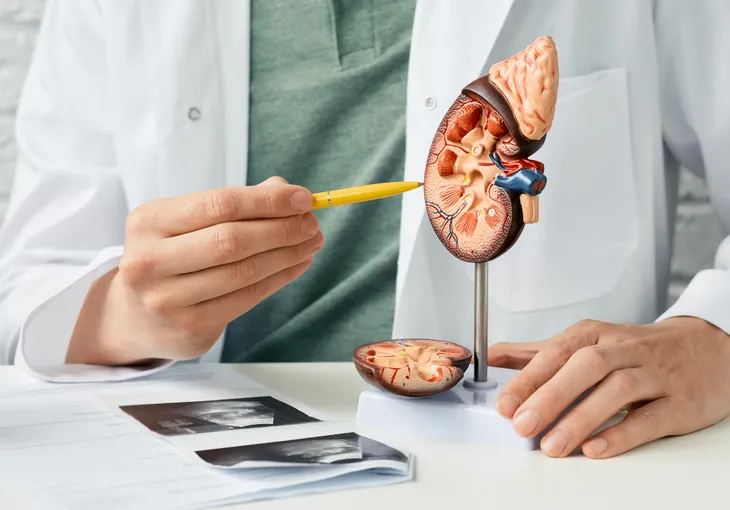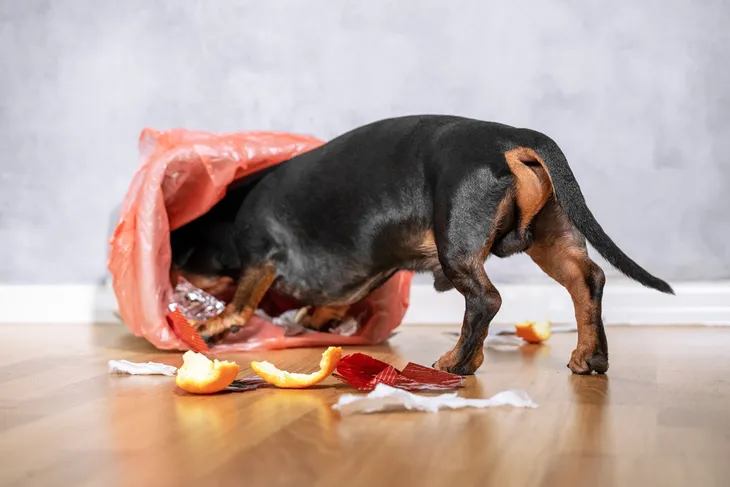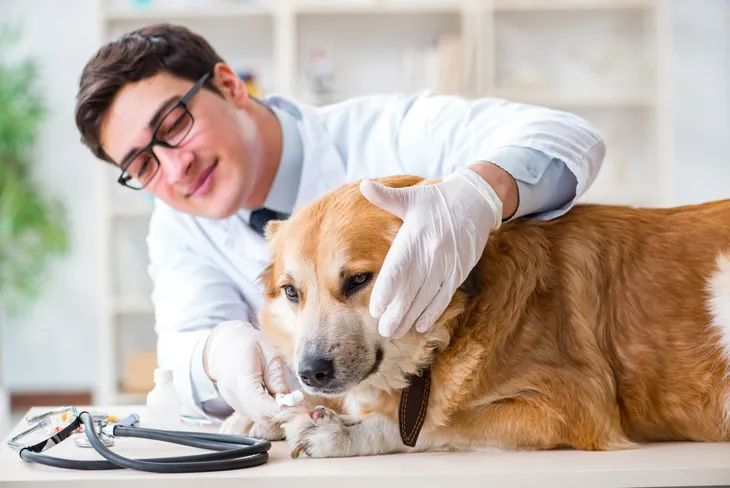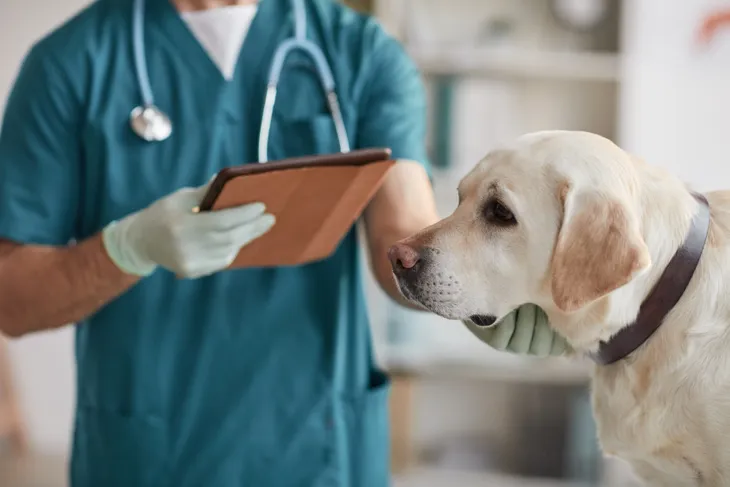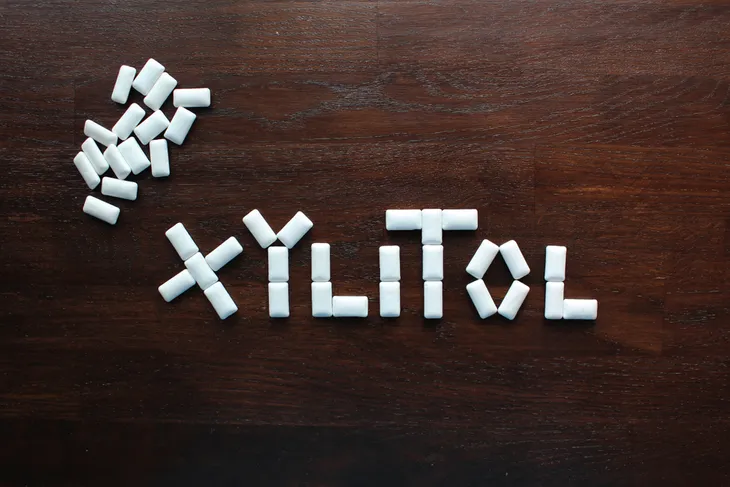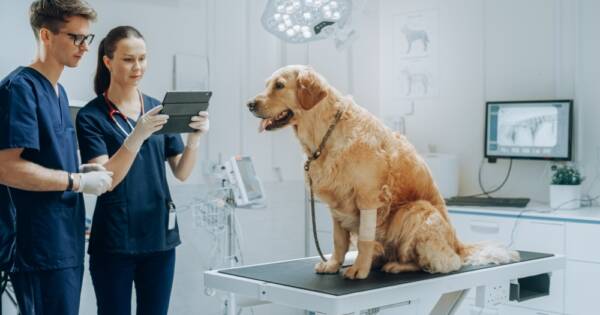- Untreated kidney disease can be life-threatening for your dog. All the more reason to get informed!
- Kidney disease can be either acute or chronic and can cause a variety of symptoms from lethargy and frequent (or decreased) urination to decreased appetite and unexplained weight loss.
- Ultimately, your dog’s life expectancy will depend on your dog, the severity of the disease, and their treatment.
Kidneys play an important role in your dog’s health. They have many functions but they mainly work to remove waste products from their bloodstream, conserve water, regulate their mineral levels, and help produce urine.
If your dog’s kidneys aren’t functioning properly, their health could be at risk! This is why it’s important to get informed by learning the signs of kidney failure so you can get your dog the help it needs. Let’s take a look at everything you need to know about kidney disease in dogs including the common signs and causes, and what treatment options are available.
What Is Chronic Kidney Disease
Chronic kidney disease, also known as chronic renal failure, is a disease that develops over a long period of time. It involves a gradual loss of kidney function. When it develops, your dog’s kidneys won’t be able to efficiently filter waste products from their blood.
If kidney disease develops in your dog, it can “cause a domino effect of health problems for your pet,” explains Fetch by WebMD. By knowing the signs and getting your dog the treatment they need, you can help improve their health.
Common Signs of Kidney Disease in Dogs
Signs can vary from dog to dog, however, some of the telltale signs of kidney disease to watch for include change in volume and frequency of urination, decreased appetite, and unexplained weight loss. Your dog may also start drinking more or less water or they may experience diarrhea or vomiting.
Kidney disease may also cause blood in the urine so be on the lookout during their bathroom breaks. Finally, kidney disease may also cause oral health problems like dental disease, says Fetch by WebMD. Be on the lookout for pale gums, smelly breath, and mouth ulcers.
When Does Kidney Disease Usually Develop in Dogs?
The VCA Animal Hospital says, “At least 2/3 of the kidneys must be dysfunctional before any clinical signs are seen.” The source also notes that reduction of the kidneys can occur for months, even years before kidney failure becomes noticeable.
In many cases, chronic kidney disease is associated with aging. As a dog ages, its kidneys “wear out,” says the source. The signs of kidney disease typically develop later (around 10- to 14-years of age) in smaller dogs because they live longer. However, larger dogs usually have a shorter life span so they may develop signs as young as 7-years old.
What Causes Acute Kidney Failure?
Fetch by WebMD explains that kidney problems can either be acute or chronic. First, let’s focus on acute kidney failure and what causes it. The source says, acute kidney failure happens suddenly and usually over a few days.
Ingesting a toxin is most likely the cause of acute kidney failure. Common toxins can be household cleaners, chemicals in your garage such as antifreeze, or even toxic food (such as grapes, chocolate, and xylitol). Your dog may also experience kidney problems from heatstroke, severe dehydration, snake bites, or a bacterial infection known as leptospirosis.
Causes of Chronic Kidney Failure
Chronic kidney failure, on the other hand, develops more slowly over time. The exact cause of chronic kidney disease can be hard to spot because of its gradual development. That said, it is known that it’s more common in older dogs.
Fetch by WebMD points out that dental disease is one of the leading causes of chronic kidney disease in older dogs. “Bacteria build up on your dog’s teeth and enter the digestive system when eating and drinking,” explains the source. The bacteria can put a strain on their kidneys and make them less effective over time. All the more reason to take care of your dog’s oral health.
Complications of Untreated Kidney Disease
Untreated kidney disease can be life-threatening for your pooch, so it’s vital that you get them the treatment they need. If you suspect your dog has kidney disease (acute or chronic) take them to your vet or after-hours emergency clinic for a diagnosis.
Getting your dog immediate medical attention is especially important if you think they ingested something toxic, time is of the essence! So how is kidney failure diagnosed? Let’s take a look at the medical tests your veterinarian may use next.
How Is Kidney Disease Diagnosed?
The VCA Animal Hospital says there are two basic tests that can help diagnose kidney problems. They include a blood chemistry analysis and a complete urinalysis.
The purpose of a blood chemistry analysis is to assess “the function of various internal organs,” explains the source. It measures levels of two waste products (blood urea nitrogen and blood creatinine) in the blood which can indicate decreased kidney function.
A urinalysis is also necessary for evaluating kidney function. The source says a “low urine specific gravity (USpG)” is the earliest indicator of kidney failure. The urinalysis will also check for protein in the urine. High levels of protein can indicate poor kidney function as well.
Treatment Options
Treatment will depend on the results of the blood test, says the VCA Animal Hospital. The source says many dogs can live happy, normal lives for many months and years following a kidney disease diagnosis if it was diagnosed early and with aggressive treatment. This is why early intervention is critical.
Treatment typically consists of two phases. The first phase is flushing the kidneys and removing toxins from their blood. After that, the goal is to manage the disease and delay its progression. Let’s take a closer look at what happens in each of these phases next.
The First Phase of Treatment
During the first phase, the goal is to flush out the kidneys and bloodstream. This process is called diuresis and it “helps mildly damaged kidney cells to function again by removing the toxic metabolites and creating a healthier environment for healing,” explains the VCA Animal Hospital. To flush out the kidneys, the source says high doses of intravenous (IV) fluids are given to your dog.
Furthermore, if your dog is vomiting or has diarrhea, your vet will need to control it with diet and medication. The source says there are three possible outcomes after the first phase of treatment. They are:
- Your dog’s kidneys will function properly again and continue to function for weeks or a few years.
- Your dog’s kidneys will resume functioning during treatment, but will fail again once treatment stops (typically after 3- to 14-days).
- The kidneys fail to resume proper function.
The Second Phase of Treatment
If the first phase of treatment is successful, your dog will move on to the second phase. The main goal is to maintain kidney function as long as possible and it can involve a variety of methods. For starters, your vet may prescribe medication and they may recommend fluid therapy at home.
To help your dog live a normal and healthy life, it’s vital that you follow your vet’s advice and at-home care instructions. Finally, your vet may also recommend a special diet. Let’s take a look at what that might entail next.
Kidney Disease-Friendly Diet
The VCA Animal hospital says the ideal diet for advanced stages of kidney failure is “lower in protein, low in phosphorus, and is not acidified.” This is because it can help reduce protein waste or metabolic toxins that can make your dog feel ill. A diet lower in protein can also help put less stress on the kidneys.
Before you go rogue on making a homemade diet for your dog, be sure to follow the guidance of your vet. Your vet will be able to recommend the best therapeutic diet and where to buy it.
Foods You Should Never Feed Your Dog
As mentioned earlier, some toxins can lead to acute kidney failure and that includes some foods. At the top of the list of foods you should never feed your dog are chocolate, coffee, caffeine, and alcohol. While some of these may seem obvious, your pooch may accidentally get into something they shouldn’t.
The American Society for Prevention of Cruelty to Animals (ASPCA) says other toxic foods your dog should never eat include grapes and raisins, macadamia nuts, and yeast dough. Be on the lookout for candy and chewing gum that contains the ingredient xylitol as it is very toxic to your dog. If your dog ingests any of these foods, contact your vet immediately.
What Is the Outlook?
While a kidney disease diagnosis can be anxiety-provoking, know that your dog may live a normal life if it’s caught early enough. Ultimately, your dog’s life expectancy will depend on your dog, the severity of the disease, and their treatment, says Daily Paws.
Don’t try to diagnose your dog on your own. If you suspect something is off, book an appointment with your vet and ask them about your dog’s risk of kidney disease.
Finally, if you don’t have pet insurance, it might be time to look at your options. Vet visits can be expensive and pet insurance is a great way to help subsidize the costs.

